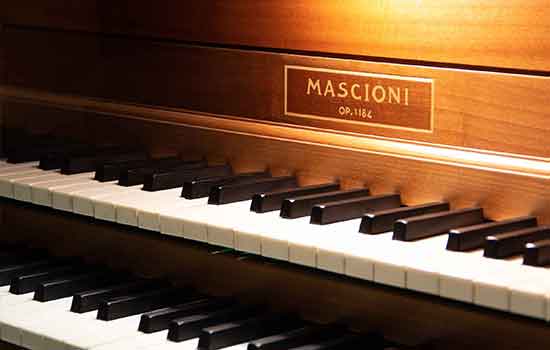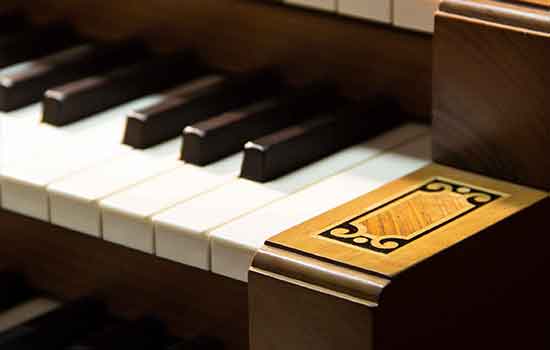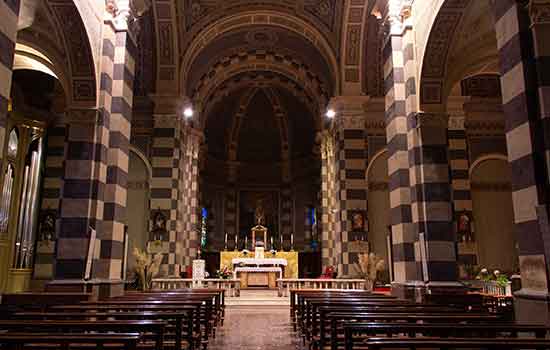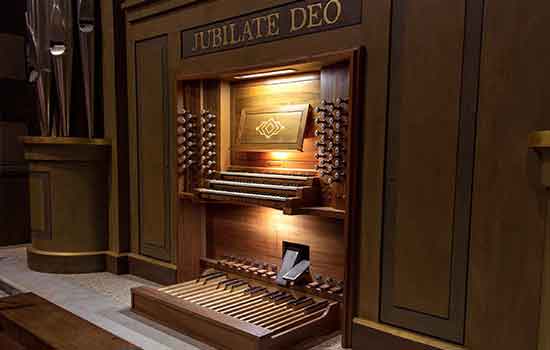Alessandria is a city in the north-west part of Italy. It is located almost just in between 3 big cities: Milan, Turin and Genoa. The church of San Giovanni Evangelista originally was built in 1905, and was successively restored during the last few years.
Thanks to the efforts of the priest of the church, Don Claudio Moschini, the new organ was built in 2010 by the well known and appreciated company Mascioni. It is a 45 stop 3 manual organ consisting of 5 divisions: Grande Organo, Positivo, Recitativo espressivo, Pedale and Tuba. The tonal composition representing romantic-symphonic style was designed by M°Massimo Nosetti. One of the very interesting features is the Tuba 8′ stop, which is supplied by a separate blower. It’s a high pressure stop running at pressure of 400 mm, which is unique in Italy. In the sample set, this blower can be activated by switching on Motore Tuba located in the left bottom corner of the Console tab. It can be configured to turn on automatically when the organ starts in the Settings tab (in the Hauptwerk version).
In the sample set a few small changes were made. On the real instrument it is possible to couple the Tuba division to only the 1st manual and pedal (at the same time, not separately), or to the 3rd manual. In the sample set the tuba is available on every division independently. Furthermore, all three manuals received independent tremulants, as on the real organ one drawknob activates the tremolo for the 1st and 2nd manual (as they share the same bellows). Also two new stops were added: Clarone 4′ in Recitativo espressivo division and Bombarda 32′ in Pedale, resulting in a 47 stops total.
The keyboards have a range from C-c4 (C2-C7) (61 notes) and the pedal from C-g1 (C2-G4) (32 notes). Because of the organ’s thoughtful conception and colorful stoplist, it is widely seen as a very beautiful and versatile instrument by numerous organists. Several of them highlighted the particular qualities of the instrument and its acoustics.
Listening perspectives
Using this audio player you can listen to different audio channels the sample set is made of.
Use the sliders corresponding for each audio group to modify its volume.
Technical details
Order
Choose which version you want to order. If you want to try the demo first, use the Add to cart button close to Demo version label and proceed to the checkout to get the download link. The only limitation of demo versions is the number of available stops. Click Show demo version button under the stoplist to see the available stops.
GrandOrgue users, please read this page before ordering.
Updates
Last update: October 2nd 2023
Downloads:
Full version 1.11 Demo version 1.11
Release notes:
1.11 - Fixed error where the tremmed ranks weren't affected by enclosure pedal. Demo versions weren't working in version 1.1.
1.10 - Performance optimizations. Now tremmed samples can be disabled from loading to save memory (in Load organ adjusting rank memory options... window). As tremmed ranks are now separate, all changes to the voicing for previous "Tremmed" layer will be lost. The sample set should perform better in terms of CPU usage.
1.01 - Added separate organ definition file for Hauptwerk 6.0.2 and higher, which improves release realism of the Campane stop. Loading and saving audio levels presets can be controlled now via MIDI. Minor bug fixes.
1.02 - Added detuning feature. Now key/stop action noises and blower/ambient noises are stored in presets, as well as the detuning level values.





